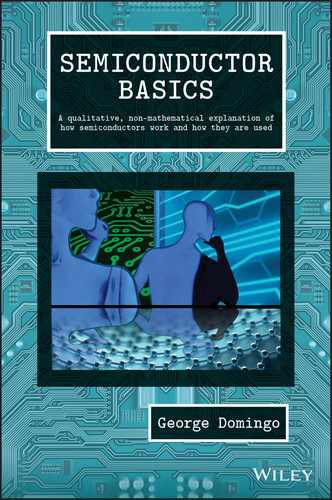An accessible guide to how semiconductor electronics work and how they are manufactured, for professionals and interested readers with no electronics engineering background Semiconductor Basics is an accessible guide to how semiconductors work. It is written for readers without an electronic engineering background. Semiconductors are the basis for almost all modern electronic devices. The author—an expert on the topic—explores the fundamental concepts of what a semiconductor is, the different types in use, and how they are different from conductors and insulators. The book has a large number of helpful and illustrative drawings, photos, and figures. The author uses only simple arithmetic to help understand the device operation and applications. The book reviews the key devices that can be constructed using semiconductor materials such as diodes and transistors and all the large electronic systems based on these two component such as computers, memories, LCDs and related technology like Lasers LEDs and infrared detectors. The text also explores integrated circuits and explains how they are fabricated. The author concludes with some projections about what can be expected in the future. This important book: Written for anyone interested in the technology, working in semiconductor labs or in the semiconductor industry, Semiconductor Basics offers clear explanations about how semiconductors work and its manufacturing process.
Table of Contents
- Cover
- Acknowledgements
- Introduction
- 1 The Bohr Atom
- 1.1 Sinusoidal Waves
- 1.2 The Case of the Missing Lines
- 1.3 The Strange Behavior of Spectra from Gases and Metals
- 1.4 The Classifications of Basic Elements
- 1.5 The Hydrogen Spectrum Lines
- 1.6 Light is a Particle
- 1.7 The Atom's Structure
- 1.8 The Bohr Atom
- 1.9 Summary and Conclusions
- Appendix 1.1 Some Details of the Bohr Model
- Appendix 1.2 Semiconductor Materials
- Appendix 1.3 Calculating the Rydberg Constant
- 2 Energy Bands
- 3 Types of Semiconductors
- 3.1 Semiconductor Materials
- 3.2 Short Summary of Semiconductor Materials
- 3.3 Intrinsic Semiconductors
- 3.4 Doped Semiconductors: n‐Type
- 3.5 Doped Semiconductors: p‐Type
- 3.6 Additional Considerations
- 3.7 Summary and Conclusions
- Appendix 3.1 The Fermi Levels in Doped Semiconductors
- Appendix 3.2 Why All Donor Electrons go to the Conduction Band
- 4 Infrared Detectors
- 5 The pn‐Junction
- 5.1 The pn‐Junction
- 5.2 The Semiconductor Diode
- 5.3 The Schottky Diode
- 5.4 The Zener or Tunnel Diode
- 5.5 Summary and Conclusions
- Appendix 5.1 Fermi Levels of a pn‐Junction
- Appendix 5.2 Diffusion and Drift Currents
- Appendix 5.3 The Thickness of the Transition Region
- Appendix 5.4 Work Function and the Schottky Diode
- 6 Other Electrical Components
- 7 Diode Applications
- 7.1 Solar Cells
- 7.2 Rectifiers
- 7.3 Current Protection Circuit
- 7.4 Clamping Circuit
- 7.5 Voltage Clipper
- 7.6 Half‐wave Voltage Doubler
- 7.7 Solar Cells Bypass Diodes
- 7.8 Applications of Schottky Diodes
- 7.9 Applications of Zener Diodes
- 7.10 Summary and Conclusions
- Appendix 7.1 Calculation of the Current Through an RC Circuit
- 8 Transistors
- 9 Transistor Biasing Circuits
- 9.1 Introduction
- 9.2 Emitter Feedback Bias
- 9.3 Sinusoidal Operation of a Transistor with Emitter Bias
- 9.4 The Fixed Bias Circuit
- 9.5 The Collector Feedback Bias Circuit
- 9.6 Power Considerations
- 9.7 Multistage Transistor Amplifiers
- 9.8 Operational Amplifiers
- 9.9 The Ideal OpAmp
- 9.10 Summary and Conclusions
- Appendix 9.1 Derivation of the Stability of the Collector Feedback Circuit
- 10 Integrated Circuit Fabrication
- 10.1 The Basic Material
- 10.2 The Boule
- 10.3 Wafers and Epitaxial Growth
- 10.4 Photolithography
- 10.5 The Fabrication of a pnp Transistor on a Silicon Wafer
- 10.6 A Digression on Doping
- 10.7 Resume the Transistor Processing
- 10.8 Fabrication of Other Components
- 10.9 Testing and Packaging
- 10.10 Clean Rooms
- 10.11 Additional Thoughts About Processing
- 10.12 Summary and Conclusions
- Appendix 10.1 Miller Indices in the Diamond Structure
- 11 Logic Circuits
- 11.1 Boolean Algebra
- 11.2 Logic Symbols and Relay Circuits
- 11.3 The Electronics Inside the Symbols
- 11.4 The Inverter or NOT Circuit
- 11.5 The NOR Circuit
- 11.6 The NAND Circuit
- 11.7 The XNOR or Exclusive NOR
- 11.8 The Half Adder
- 11.9 The Full Adder
- 11.10 Adding More than Two Digital Numbers
- 11.11 The Subtractor
- 11.12 Digression: Flip‐flops, Latches, and Shifters
- 11.13 Multiplication and Division of Binary Numbers
- 11.14 Additional Comments: Speed and Power
- 11.15 Summary and Conclusions
- Appendix 11.1 Algebraic Formulation of Logic Modules
- Appendix 11.2 Detailed Analysis of the Full Adder
- Appendix 11.3 Complementary Numbers
- Appendix 11.4 Dividing Digital Numbers
- Appendix 11.5 The Author’s Symbolic Logic Machine Using Relays
- 12 VLSI Components
- 13 Optoelectronics
- 14 Microprocessors and Modern Electronics
- 15 The Future
- Epilogue
- Appendix A: Useful Constants
- Appendix B: Properties of Silicon
- Appendix C: List of Acronyms
- Additional Reading and Sources
- Index
- End User License Agreement
